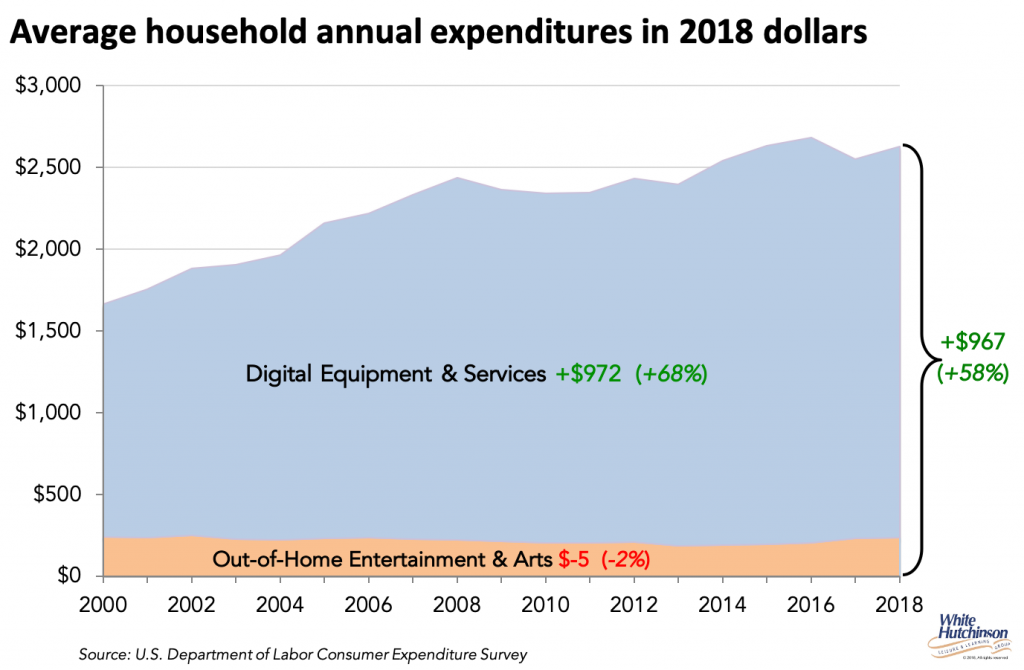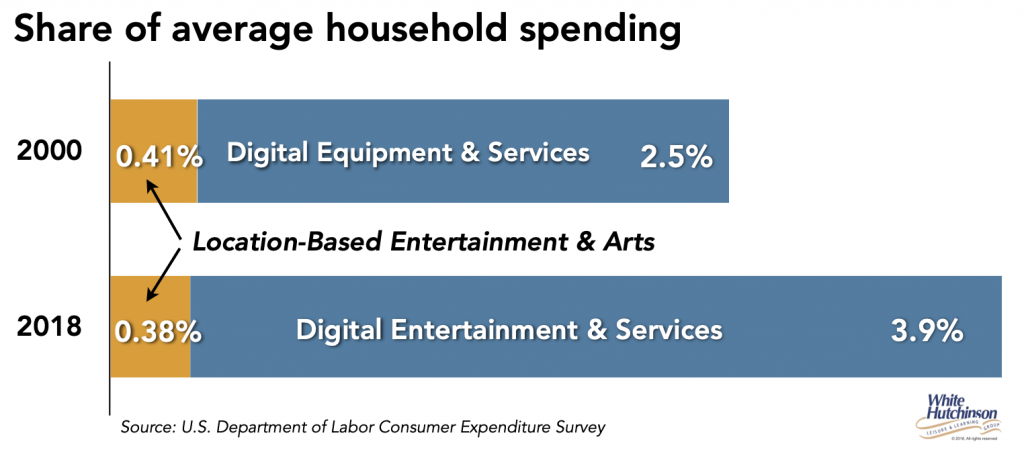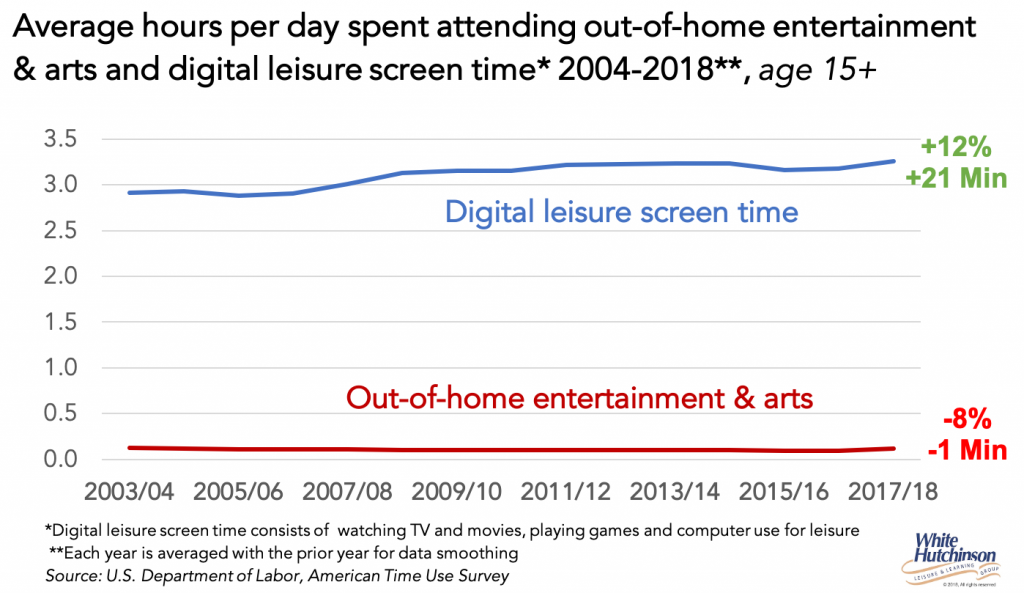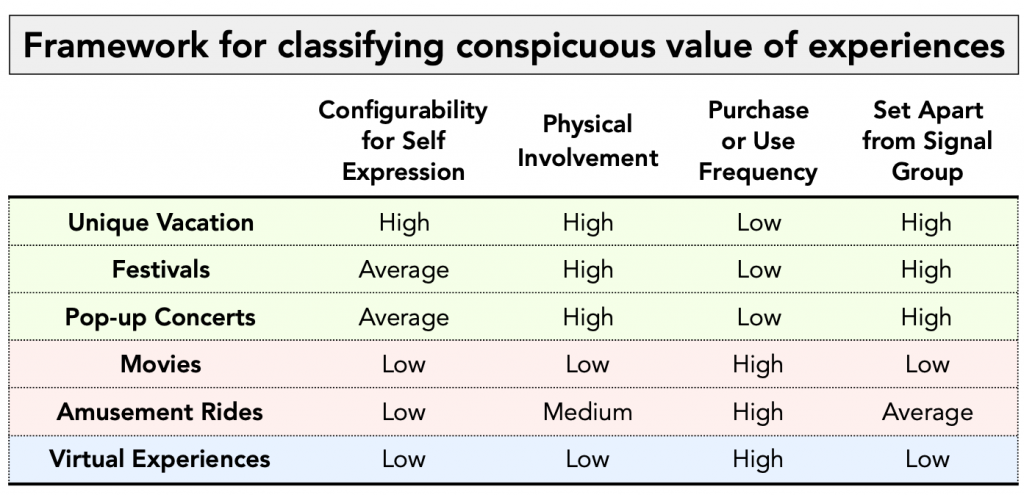No different than what happened following catastrophes such as World War I, World War II and the Great Depression, the coronavirus crisis is acting as a catalysis to accelerate trends that were already underway for how we live, work and play and may also generate some changes we might not have imagined. We will not stay indoors forever, but our habits will be permanently changed by this period of isolation. What might the long-term impact be on our out-of-home entertainment behavior once the corona-crisis is over?
Over the past few decades we were already seeing the slow digitalization of just about every type of out-of-home activity, what our company has labeled ‘the digitalization of place’ and some have called ‘the death of distance.’ This has included the explosion and adoption of a multitude of at-home entertainment and digital social options. This trend is evidenced by changes in spending on digital leisure equipment and services. From 2000 to 2018, average household spending (inflation-adjusted) on digital equipment & services grew by 68% whereas spending on fees and admissions to out-of-home entertainment and art venues declined by 2%.

Likewise, the share of all household spending on digital equipment & services grew from 2.5% to 3.8% while the share for out-of-home entertainment and arts declined from 0.41% to 0.38% of all household spending. Pre-pandemic household digital spending had grown to ten times that of out-of-home entertainment and arts.

The trend of more digital and less out-of-home entertainment is also evidenced by the time people spend on each. From 2003 to 2018, time spent by ages 15+ on digital entertainment and socialization increased by 12%, 21 minutes more each day, while time attending out-of-home entertainment and art venues declined by 8%.

Currently, with everyone on lockdown, the pandemic has accelerated the shift to at-home entertainment and digital socialization – 100% overnight. Now our social lives and entertainment experiences have moved exclusively to our at-home online and digital options. In the absence of attending out-of-home entertainment and other leisure activities including dining out, quarantined people have turned to craving all means of online social connection and digital entertainment to overcome boredom, cabin fever and for escapism from coronavirus stress. Even people who previously didn’t turn to social media and many forms of digital entertainment are learning to use it. Are we going to develop at-home entertainment and socialization habits during the crisis that will continue post-crisis and disrupt the out-of-home entertainment and social landscapes as we once knew them?
Pre-crisis, two basic human needs significantly influenced and drove peoples’ desire to visit and their choices of which out-of-home leisure experiences they visited.
Most out-of-home leisure experiences were communal and highly social. Research has consistently found that the primary reason people do go out, whether to an entertainment venue, restaurant, concert, museum, sporting event, festival, or just about any other out-of-home leisure destination, is to socialize with family and friends. We evolved as a social species. We were able to survive as a species by being tightknit and cooperative members of families, tribes and larger groups. We are hardwired by evolution to crave social interaction. Our need to connect with other humans is as fundamental as our need for food and water.
The second basic human need was identified by Maslow in his fourth level of the Hierarchy of Needs, “esteem, recognition and respect.” Maslow recognized that people need to seek status and elevate their social position in the eyes of their peers. Until recently, conspicuous consumption of things was one of the main ways people gained status, whether it was some logo on their clothing, the car they parked in their driveway or the purse they carried. Gaining status for owning status-worthy things took time as it required time for a person’s social signaling group to be exposed to and see those items. Then we saw the nascent emergence of the experience economy first identified by Joe Pine and James Gilmore in their Harvard Business Review article in 1998 and then in 1999 in their book, The Experience Economy. The introduction of the smartphone in 2007 with its ability to simultaneously post and broadcast on social media photos of must-attend envious experiences people were having was a driving force in the transition to the experience economy and the shift from the conspicuous consumption of stuff to conspicuous leisure.
There’s been a shift of peoples’ identity from “I am what I own” to “I am what I do.” Now, the vast majority of people would rather be known for their experiences than their possessions. And the more status-worthy experiences you can have and post, the greater your social capital. So, people are constantly seeking new and unique experiences that their social media followers haven’t experienced and will be envious of, will wish they could do. Signaling your identity and gaining social capital has shifted to the experiences we have and post on social media. In fact, for many people, especially younger adults, if some experience isn’t Instagrammable, it probably isn’t worth doing.There’s also another motivation for photographing experiences and posting them on social media. Studies have found that sharing photos increases a person’s enjoyment of experiences. The act of self-disclosure of what you’ve done plus the validating feedback you receive from social media likes and feedback releases dopamine in the pleasure center of the brain. This chemical reaction is a big part of why social media can be so addictive.
shareworthy experience ® post ® pleasure & social currency
Up until the great coronavirus lockdown, social media conspicuous leisure postings were for in-real-life experiences. The preference for unique, socially-sharable, out-of-home experiences has strongly influenced peoples’ choice of the events they attend. That shareworthy preference has produced whole new categories of out-of-home leisure experiences specially designed to offer highly interactive, social and Instagrammable experiences including many festivals and immersive pop-up museums and art exhibits.
But during the pandemic, people still have their evolutionary programmed need to socialize as well as get their status fix and build their social currency. They no longer can meet face-to-face nor post shareworthy out-of-home experiences. Will we see the development of virtual experiences that people value and want to share, as much as real world experiences? Will quarantined people start posting screen-capture photos of ‘must-attend’ streaming events that are shareworthy enough to create social currency and FOMO? Will they engage in and share other virtual digital experiences in other new ways to gain status currency? Will these become habits rather than temporary pandemic replacements, causing a permanent shift to virtual, digital shareworthy status-accruing experiences and how we socialize?
Many digital entertainment experiences also have a high social component And just like a lot of streaming video games and esports, they can be a means for gaining status,. For example, Fortnite not only has a highly social component, but also offers social currency opportunities through “wins “and the acquisition of “skins” and other game achievements. NASCAR has streamed iRace, virtual racing by real NASCAR drivers. Now virtual concerts abound. We’re now seeing the evolution of other virtual experiences such as virtual cocktail parties, virtual rave parties, apps for co-watching and even virtual graduations at college campuses created on Minecraft. Even before the pandemic, we were seeing younger people creating and uploading videos on YouTube and TikTok of at-home experiences to their followers. No need to leave home to have some shareworthy, status-worthy and social experience.
Other forms of virtual entertainment may evolve during the pandemic that is both highly social and shareworthy. Post-crisis we may no longer have as great a need to meet up out-of-home for communal entertainment if we have learned that we can get the same feeling of togetherness and develop social currency virtually.
However, there are four key requirements in order for experiences to have high conspicuous value that are difficult, if not impossible, to replicate virtually:
- How involved you are in participating and shaping the experience, as passive involvement has low conspicuous value.
- Are you be physically evolved? Lack of physical involvement has low value.
- How often and how many people participate in the experience? Experiences with wide regular participation have low value as shareworthy as they are not unique and lack limited access.
- How unique is the experience from those that your social media followers have? The more unique, the higher the conspicuous value.

Most virtual experiences are readily available to everyone, so they lack exclusivity and uniqueness. To truly have some shareworthy conspicuous value, they will have to be offered as one-time events to a limited audience, perhaps through limited sale of virtual tickets. We may see that development soon. However, the physical aspect will always be lacking. That is until sometime in the not too far future we see mainstream adoption of XR (mixed reality including VR) that blurs the line between the physical and digital worlds, creating an experience with an immersive presence and good haptic capabilities that can replicate the sense of being in a different environment.
Until that time when we can once again leave our homes and there is a new normal, out-of-home entertainment should still reign king for conspicuous leisure, although we will have learned to place less value on proximity for social and entertainment experiences and more on our digital options. The pre-pandemic trends of the growth of digital entertainment and socialization is sure to have been accelerated and should continue post-pandemic as digital options continue to evolve and improve.




